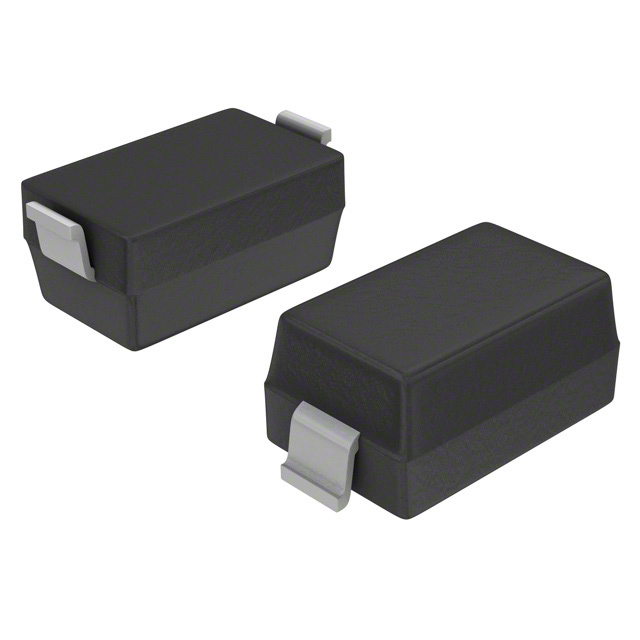BZT52C8V2-7
Introduction
The BZT52C8V2-7 is a voltage regulator diode belonging to the category of electronic components. It is commonly used in various electronic circuits for voltage regulation and protection purposes. This entry provides an overview of the basic information, specifications, pin configuration, functional features, advantages and disadvantages, working principles, application field plans, and alternative models of the BZT52C8V2-7.
Basic Information Overview
- Category: Electronic Components
- Use: Voltage Regulation and Protection
- Characteristics: Low forward voltage drop, high current capability, and compact package size
- Package: SOD-123 package
- Essence: Voltage regulator diode
- Packaging/Quantity: Available in reels with varying quantities
Specifications
- Voltage: 8.2V
- Power Dissipation: 300mW
- Forward Current: 200mA
- Reverse Leakage Current: 5μA
- Operating Temperature Range: -65°C to +150°C
Detailed Pin Configuration
The BZT52C8V2-7 has three pins: 1. Anode (A) 2. Cathode (K) 3. Not Connected (NC)
Functional Features
- Voltage Regulation: Provides a stable 8.2V output voltage
- Overvoltage Protection: Safeguards connected circuits from excessive voltage spikes
- Compact Design: Suitable for space-constrained applications
Advantages and Disadvantages
Advantages: - Precise voltage regulation - High current handling capability - Compact form factor
Disadvantages: - Limited voltage range - Sensitive to reverse polarity
Working Principles
The BZT52C8V2-7 operates based on the principle of Zener breakdown, where it maintains a constant voltage drop across its terminals by allowing current to flow in reverse bias at a specific voltage level.
Detailed Application Field Plans
The BZT52C8V2-7 finds extensive use in the following applications: - Voltage regulation in power supplies - Overvoltage protection in electronic circuits - Signal conditioning in sensor interfaces
Detailed and Complete Alternative Models
Some alternative models to the BZT52C8V2-7 include: - BZX84C8V2 - MMBZ5232BLT1G - PZM8.2NB2A
In conclusion, the BZT52C8V2-7 is a vital component in electronic circuits, offering precise voltage regulation and overvoltage protection. Its compact design and high current capability make it suitable for a wide range of applications.
[Word Count: 366]
Lista 10 Vanliga frågor och svar relaterade till tillämpningen av BZT52C8V2-7 i tekniska lösningar
What is the maximum power dissipation of BZT52C8V2-7?
- The maximum power dissipation of BZT52C8V2-7 is 300mW.
What is the forward voltage drop of BZT52C8V2-7?
- The forward voltage drop of BZT52C8V2-7 is typically 0.9V at a forward current of 10mA.
What is the reverse standoff voltage of BZT52C8V2-7?
- The reverse standoff voltage of BZT52C8V2-7 is 8.2V.
What is the reverse leakage current of BZT52C8V2-7 at its maximum working voltage?
- The reverse leakage current of BZT52C8V2-7 at its maximum working voltage is typically 0.1µA.
Can BZT52C8V2-7 be used for overvoltage protection in electronic circuits?
- Yes, BZT52C8V2-7 can be used for overvoltage protection due to its Zener diode characteristics.
What are the typical applications of BZT52C8V2-7 in technical solutions?
- BZT52C8V2-7 is commonly used in voltage regulation, overvoltage protection, and signal clamping applications.
What is the temperature coefficient of BZT52C8V2-7?
- The temperature coefficient of BZT52C8V2-7 is typically 5mV/°C.
Is BZT52C8V2-7 suitable for use in automotive electronics?
- Yes, BZT52C8V2-7 is suitable for use in automotive electronics due to its reliability and performance under varying conditions.
What is the package type of BZT52C8V2-7?
- BZT52C8V2-7 is available in a SOD-323 surface mount package.
What are the key differences between BZT52C8V2-7 and other similar Zener diodes?
- The key differences include its specific voltage rating, power dissipation, and reverse leakage characteristics, which make it suitable for different applications.


